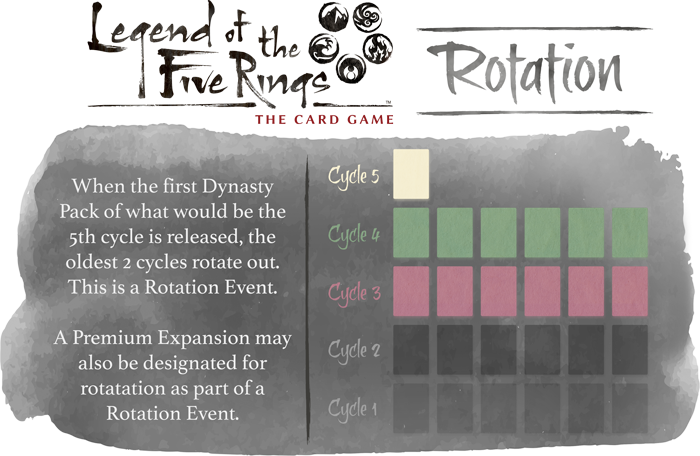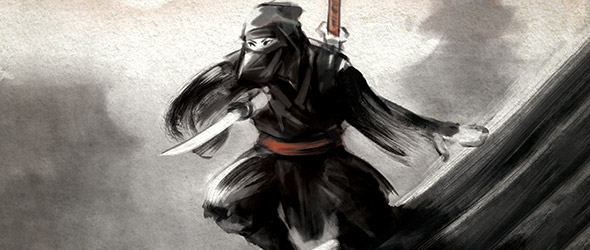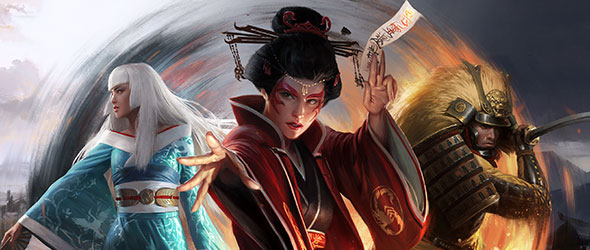The Second Black Scroll – The Shape of the Game

In the last article I talked about some of the design decisions we’re seeing in the game and how I disagree with some of them. I ended by suggesting that player-run tournaments could introduce their own formats with deck construction limitations and minor game changes. I didn’t really go into any details, I just vaguely hand-waved as if it was easy. Obviously, it is not easy. So here are some possible suggestions on groups of cards that could be banned.
Rotation – The original plan was to drop the 1st and 2nd cycles, the Imperial Cycle and the Elemental Cycle, as soon as the first pack of the 5th cycle, Temptations, was released. In the article discussing it, FFG referred to it as a ‘pruning’ to prevent old cards from choking new ideas and to leave room for new players to enter the garden. A pretty way of saying, removing old cards that had been staples gives room for other cards to see some play and limiting the size of the card pool makes it easier for new players to join in.

Unfortunately, this approach was abandoned on the basis that the card pool was too small. A review of the cards that would be leaving, however, shows that the majority of cards leaving aren’t currently being played anyway. Unfortunately, the narrow card pool is more a reflection of design continuing to print cards that don’t see any play. It was implied that this would come along with a new core set, allowing the design team to retain some of the cards from the first two cycles and to remove some of the original core cycles cards. That said, it is possible to have a meaningful rotation without a new core set.
Why bother? Well, removing the first two cycles shakes things up. Cards like Hiruma Skirmisher, Soul Beyond Reproach, Void Fist, A Legion of One, Consumed by Five Fire, Backhanded Compliment, Talisman of the Sun, and Censure all go away. These are all powerful cards that see a lot of play but aren’t so impactful that they’re worth banning or restricting. Cycling them out openings up room for other options and changes the game up. Reducing the number of cycles that are legal also makes the buy-in for new players a little easier. Currently, they need to get 3 cores, 2 big box expansions, 7 clan expansions, and 24 dynasty packs. This would only remove 12 dynasty packs from the list, but it would be a help.
Mono No Aware – At the start of the game, every person on the development team threw this ‘Mono no aware’ term around, the awareness of the impermanence of things. It was supposed to be a core mechanic of the game that differentiated it from other card games. Characters came into play with fate on them, and once all that fate was gone, they were discarded. That’s not really how the game plays anymore. Removal and save effects distort this core tenet, and instead we see characters stick around all game or characters with lots of fate on them suddenly disappear in tragic circumstances.
This ban list looks to remove every card that either kills or saves a character. That includes any card that removes fate from an opponent’s character or adds fate to your own characters. That leaves the ring of Void as the only way to meddle with a character’s fate. You can still give fate to your opponent’s characters or remove fate from your own characters, put once fate is placed on a character you have a pretty reliable indication of how long they are going to stick around.

Counterspells – Cards with interrupts which can prevent the effects of another card have proven to be incredibly powerful. Forged Edict recently was banned and Voice of Honor remains a staple in all Crane decks. These along with Defend Your Honor and Censure are notable as they are 0 fate cost cancels that are either on, as their conditions are met, or are off. Cards like Guest of Honor and Utaku Tetsuko which pre-emptively stop you playing cards fit a similar mode, on one hand, you don’t lose the resources of the card being played but it is a blanket effect impacting all your events rather than just one card.
Throughout many games the debate over whether cancels are good for the game or not is contentious. Having cancels in the environment does allow combo win decks to exist without becoming dominate. The counters prominent in L5R however, all have conditions that you’re planning to fulfil anyway and as they don’t cost fate, you can play multiple copies. This means they can be used to push through a combo as much as they stop them, and in effect, these limit combo cards to decks that can run enough counters to protect them from other decks!
Counters fit an interesting segment of the game, a game between two decks with counters can be incredibly tactical as each player attempts to gauge what cards they can afford to use their cancel against. As the game progresses, you end up with chess-like situations where both players gauge the game and try work out how many cancels their opponent have with the final play often have 2 or more cancels played on each side on a crucial moment. When only one player has counters, it’s a very different game. If they’re behind then the cancels do little as they aren’t proactive and if they’re ahead then the cancels stop their opponent’s attempts to claw back into the game.
In this variant, we ban every card that cancels an effect or prevents an effect from happening. So Forged Edict and Censure go, but so do Guest of Honor and Ageless Crone. In this environment, if you can play a card it will resolve. Expensive cards will happen if you have the fate and you don’t have to worry about the investment all being lost with a single cancel. Optionally, you could also remove effects that steal or destroy attachments, removing the same investment risk for attachments. This does make those cards more powerful, the only counterplay is essentially playing more cards on your side to try to find a balance.

Ready Effects – In a similar vein to control and saves from the Mono No Aware variant, being able to straighten a character has a massive impact. It is essentially the core of the ‘Tower’ style of deck where a powerful character ends up in multiple conflicts. Like the Mono No Aware change, this is a way to stabilise the games internal economy. Each side has 7 fate per turn but readying a 5 fate character has such a massive impact on the game that it’s almost like gaining 5 fate from the effect. When you do not have any cards with straighten effects (leaving only the Water Ring) then the mechanics of a turn are far more predictable allowing for greater tactical decisions. Each character will only get to contribute their skill to one conflict only. It may be possible to move them into another conflict, but you’re not going to be able to ready them again.
The Three Pillars – We’ve spoken before about the 3 pillars of degenerate gameplay; cost reduction, recursion, and card draw. On that basis, this list attempts to pull down those pillars before they ever become a problem. So, any card that provides fate reduction or extra fate is gone. All cards that take cards from a discard pile are gone. More drastically, any card that draws more than 1 card goes. This combined set of bans hits a large number of totally fine cards, but it also removes what we see as the three main sources of problems.

In the above, I’ve provided broad categories without detailing the actual cards. On one hand, the lists would need to be updated with every new release, which would be a pain in the ass. Structuring it like this served another purpose though, grouping the cards into these categories allows us to talk about these kinds of effects. In each group, there are cards which aren’t causing problems and probably aren’t even seeing play. I have no doubt that everyone reading this will have objected to at least one group. The proposal here is not to ban all the cards that fit the above categories, but instead to look at them as options. Each list will have a big impact on the game, and it’s important to consider whether that is something you want or not.
The L5R LCG core design diverges from the typical collectable card game design in many respects. Crucially, this means that card designs that work for other games aren’t going to work in this game. The economy doesn’t ramp but instead is relatively static with players having the same amount of fate on turn 1 as they do on turn 10. That means a kill effect with unlimited targets can take out a 1 fate investment or a 7 fate investment on turn 1. Similarly, a ready effect could be readying a 1 fate or 7 fate worth of investment (whether that’s a 5 cost character or a 1 cost character with 7 fate with of attachments. As turns happen simultaneously, you don’t save counters for during your opponent’s turn, so you never have to deal with the wasted 2 blue mana if you decide not to play a counter, an issue exasperated as the most played counters cost 0 fate.
The decision to ban cards is always a difficult one, but in this instance, it’s more like pruning a bonsai tree. Current card design is, in my opinion, lacking focus and is growing in all directions creating a chaotic game. Cutting away parts of the bonsai tree does inflict trauma on the tree, but it’s done to make sure the tree maintains the desired shape. Similarly, we need to decide the desired shape of the L5R LCG, what elements we feel makes the game unique and enjoyable, and trim away those cards that grow away from that core.
If you have any comments or feedback please post them in the comments section below. Check us out on the Imperial Advisor website, podcast, and YouTube channel for more discussion about the L5R LCG.
